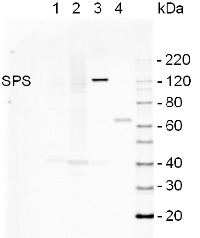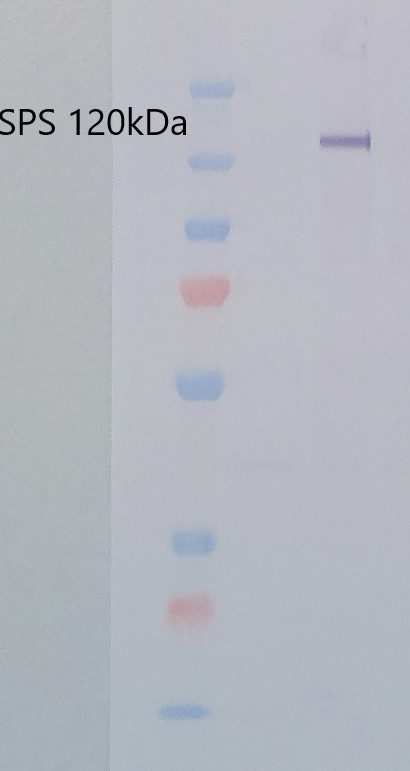1

Anti-SPS | Sucrose phosphate synthase (maize)
AS06 185 | Clonality: Polyclonal | Host: Rabbit | Reactivity: Alfalfa, Z.mays, S.lycopersicum | cellular [compartment marker] of cytoplasm
- Product Info
-
Immunogen: Synthetic peptide derived from Zea mays SPS protein sequence (P31927).
Host: Rabbit Clonality: Polyclonal Purity: Total IgG. Protein G purified in PBS pH 7.4. Format: Lyophilized Quantity: 50 µl Reconstitution: For reconstitution add 50 µl of sterile water Storage: Store lyophilized/reconstituted at -20°C; once reconstituted make aliquots to avoid repeated freeze-thaw cycles. Please remember to spin the tubes briefly prior to opening them to avoid any losses that might occur from material adhering to the cap or sides of the tube. Tested applications: Immunolocalization (IL), Western blot (WB) Recommended dilution: 1 : 1500 (IL), 1 : 2000 (WB) Expected | apparent MW: 120 | ~130 for Zea mays
- Reactivity
-
Confirmed reactivity: Alfalfa, Solanum lycopersicum, Zea mays Predicted reactivity: Oryza sativa, Saccharum officinarum, Triticum aestivum
Species of your interest not listed? Contact usNot reactive in: Hordeum vulgare - Application Examples
-
Application example

10 µg of total leaf protein from Arabidopsis thaliana (1,2), Zea mays (3) and Hordeum vulgare (4), extracted with Agrisera Protein Extraction Buffer, PEB (AS08 300) as well as 10 µg cytosolic protein from Arabidopsis thaliana (2) were separated on 4-12% NuPage (Invitrogen) LDS-PAGE and blotted 1.5h (30V) to nitrocellulose. Filters were blocked 1h with 2% low-fat milk powder in TBS-T (0.1% TWEEN 20) and probed with anti-SPS (AS06 185, 1:2000, 1h) and secondary anti-rabbit (1:20000, 1 h) antibody (HRP conjugated) in TBS-T containing 2% low fat milk powder. Antibody incubations where followed by washings in TBS-T (15, +5, +5, +5 min). All steps were performed at RT with agitation. Signal was detected with chemiluminescence detection reagent, using a Fuji LAS-3000 CCD (90s, high sensitivity).

Samples:
1 - MW marker
2 - 10 µg of Arabidopsis thaliana whole leaf extract
3 - 10 µg of Zea mays whole leaf extract
10 µg/well of total protein extracted from respective species using PEB extraction buffer (AS08 300) and denatured with Invitrogen LDS sample buffer (4X) at 70°C/5 min. Samples were separated on Invitrogen NuPage Bis-Tris 4-12% SDS-PAGE and blotted for 1 h to Invitrogen PVDF (pore size of 0.45 µm), using: wet transfer. Blot was blocked with 5% milk in TBS-T for: ON/4°C with agitation. Blot was incubated in the primary antibody at a dilution of 1: 1 500 for 1h/RT with TBS-T Blocking. The antibody solution was decanted, and the blot was rinsed briefly twice, then washed once for 10 min and 2 times for 5 min in TBS-T at RT with agitation. Blot was incubated in matching secondary antibody (anti-rabbit IgG ALP conjugated, AS09 607 lot 2105) diluted to 1: 4 000 in TBS-T Blocking for 50min/RT with agitation. The blot was washed as above and developed with AS19 BCIP-NBT-PLUS lot 09269221 for 0,5 min. As soon as the desired band is detectable, briefly wash the membrane in generous amounts of deionized water. Transfer the membrane to fresh deionized water and incubate for 2 minutes with agitation. Change the water and incubate again for 5 minutes with agitation before placing the membrane on Whatman paper to dry. Image was captured after 1h.
Courtesy Agrisera - Additional Information
-
Additional information: Total IgG concentration is 3 µg/µl
- Background
-
Background: SPS (sucrose phosphate synthase, EC 2.4.1.14) is the key enzyme of carbon flux into sucrose fixation in plants. It catalyzes the synthesis of sucrose-phosphate from UDP-glucose and fructose-6-phosphate predominantly in the cytosol of sucrose-source leaf tissue.
- Product Citations
-
Selected references: Padhi et al. (2019). Distinct nodule and leaf functions of two different sucrose phosphate synthases in alfalfa. Planta (2019). https://doi.org/10.1007/s00425-019-03261-9.
Kaur et al. (2019). Comparison of alfalfa plants overexpressing glutamine synthetase with those overexpressing sucrose phosphate synthase demonstrates a signaling mechanism integrating carbon and nitrogen metabolism between the leaves and nodules. Plant Direct, Volume3, Issue1, Jan 2019, e00115.
Seger et al. (2014). Impact of concurrent overexpression of cytosolic glutamine synthetase (GS 1 ) and sucrose phosphate synthase (SPS) on growth and development in transgenic tobacco. Planta. 2014 Sep 12.
Rounis et al. (2014). Seeded and Parthenocarpic Cherry Tomato Fruits Exhibit Similar Sucrose, Glucose, and Fructose Levels, Despite Dissimilarities in UGPase and SPS Gene Expression and Enzyme Activity. J Plant Growth Regul. DOI 10.1007/s00344-014-9441-1. (immunolocalization) - Protocols
-
Agrisera Western Blot protocol and video tutorials
Protocols to work with plant and algal protein extracts - Reviews:
-
This product doesn't have any reviews.
Accessories

AS03 035A | Clonality: Polyclonal | Host: Rabbit | Reactivity: [global antibody] for di and monocots | cellular [compartment marker] of cytoplasm for photosynthetic tissues.
Benefits of using this antibody


